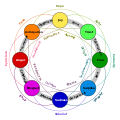History
The concept of EWB has roots in psychology, dating back over 150 years. Its origins can be traced to the "basic emotion" approach in psychology, often attributed to Charles Darwin. [3]
In 1998, Sarah Stewart-Brown highlighted the potential significance of EWB research:
"Solutions to apparently intractable public health problems like inequalities in health and unhealthy lifestyles may therefore lie in research into emotional wellbeing. A broad range of studies is needed to test the hypothesis that emotional distress creates susceptibility to physical illness, and a further range is to research interventions which can prevent emotional distress and promote mental and social health." [1]
Emergence as a discipline
In 2018, two major initiatives called for the advancement of EWB as a distinct field. A group of researchers led by Sophie C. Feller proposed a national EWB initiative with six components, including structured measurement of EWB and identification of its drivers. [4] The National Center for Complementary and Integrative Health and the Office of Behavioral and Social Sciences Research, along with other National Institutes of Health (NIH) institutes, also sponsored a roundtable discussion on EWB, focusing on developing and testing intervention strategies. [5]
These calls recognized that high EWB correlates with improved general health, enhanced disease-specific outcomes, decreased disability rates, and reduced mortality rates. [6]
In 2023, a group of researchers led by Crystal L. Park conceptualized a working definition and framework for EWB. [2]
Definition
Researchers consider EWB to consist of multiple dimensions that include an individual's current general emotional state and their feelings about life. [7]
Definitions of EWB have been inconsistent in the existing literature. [8]
EWB has been conceptualized as including experiential and reflective features in the context of culture and life circumstances. [2]
Based on her root cause research on emotional balance, Tomi White Bryan defined EWB as "a continuous sense of happiness and satisfaction caused by a balanced emotional operating system formed by positive self-perceptions of worth and authority." [9] In her model of EWB, emotional balance results in navigating life's complexities through connection and collaboration by engagement as opposed to entanglement. [9]
Distinction from well-being and wellness
While often used interchangeably, EWB, well-being, and wellness have distinct meanings: [9]
- EWB focuses specifically on the emotional aspects of human experience. [9]
- Well-being is broader, encompassing mental, physical, and emotional states. [10]
- Wellness refers to the approaches taken to achieve these states. [9]
The World Health Organization defines overall well-being as "a positive state experienced by individuals and societies... determined by social, economic and environmental conditions" that "encompasses quality of life, as well as the ability of people and societies to contribute to the world in accordance with a sense of meaning and purpose." [10]
Models
There are few models dedicated only to EWB:
Multidimensional conceptual framework
Park and her colleagues developed a multidimensional conceptual framework for EWB that includes hedonic (momentary emotional states), evaluative (life satisfaction), and eudaimonic (sense of meaning and purpose) components. [11] [2]
Emotional Balance Method
Developed by Bryan, this model focuses on the root cause of EWB: the balance or imbalance of the emotional operating system. [11] [12] [13] The model posits that EWB results from emotional balance, which determines the quality of relationship dynamics with self, others, life, and the broader system through three primary dimensions: connection, collaboration, and communication. [13] According to this model, the early childhood experiences that contribute to emotional imbalance result in three emotional safety strategies that can disrupt relationship dynamics, creating distance in relationships with self, others, and life. [13]
Reactivity and reappraisal model
A study by NIH's NEW Brain Aging research network proposed a reactivity and reappraisal model to understand EWB in relation to brain aging. [14] This model examines the interactions between affective stimuli, behavioral/physiological responses, emotional states, and feelings. [14] It integrates insights from cross-species studies on emotional brain networks and identifies unique emotional processes relevant to aging humans. [14]
This page is based on this
Wikipedia article Text is available under the
CC BY-SA 4.0 license; additional terms may apply.
Images, videos and audio are available under their respective licenses.

